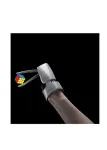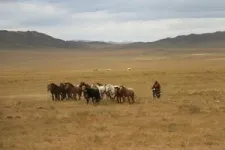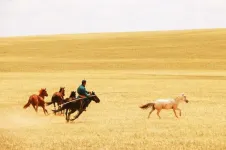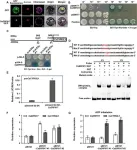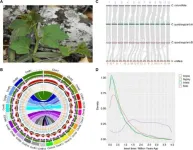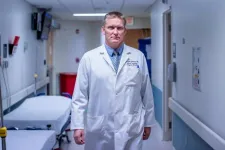(Press-News.org) Some say the next step in human evolution will be the integration of technology with flesh. Now, researchers have used virtual reality to test whether humans can feel embodiment—the sense that something is part of one’s body—toward prosthetic “hands” that resemble a pair of tweezers. They report June 6 in the journal iScience that participants felt an equal degree of embodiment for the tweezer-hands and were also faster and more accurate in completing motor tasks in virtual reality than when they were equipped with a virtual human hand.
“For our biology to merge seamlessly with tools, we need to feel that the tools are part of our body,” says first author and cognitive neuroscientist Ottavia Maddaluno (@OMaddaluno), who conducted the work at the Sapienza University of Rome and the Santa Lucia Foundation IRCCS with Viviana Betti (@Viviana_Betti). “Our findings demonstrate that humans can experience a grafted tool as an integral part of their own body.”
Previous studies have shown that tool use induces plastic changes in the human brain, as does the use of anthropomorphic prosthetic limbs. However, an open scientific question is whether humans can embody bionic tools or prostheses that don’t resemble human anatomy.
To investigate this possibility, the researchers used virtual reality to conduct a series of experiments on healthy participants. In the virtual reality environment, participants had either a human-like hand or “bionic tool” resembling a large pair of tweezers grafted onto the end of their wrist. To test their motor ability and dexterity, participants were asked to pop bubbles of a specific color (by pinching them with their tweezers or between their index finger and thumb). For this simple task, the researchers found that participants were faster and more accurate at popping virtual bubbles when they had tweezer-hands.
Next, the team used a test called the “cross-modal congruency task” to compare implicit or unconscious embodiment for the virtual hand and bionic tool. During this test, the researchers applied small vibrations to the participants’ fingertips and asked them to identify which fingers were stimulated. At the same time, a flickering light was displayed on the virtual reality screen, either on the same finger as the tactile stimulus or on a different finger. By comparing the participants’ accuracy and reaction times during trials with matched and mismatched stimuli, the researchers were able to assess how distracted they were by the visual stimulus.
“This is an index of how much of a mismatch there is in your brain between what you feel and what you see,” says Maddaluno. “But this mismatch could only happen if your brain thinks that what you see is part of your own body; if I don’t feel that the bionic tool that I’m seeing through virtual reality is part of my own body, the visual stimulus should not give any interference.”
In both cases, participants were faster and more accurate at identifying which of their real fingers were stimulated during trials with matched tactile and visual stimuli, indicating that participants felt a sense of embodiment toward both the virtual human hand and the tweezer-hands.
However, there was a bigger difference between matched and mismatched trials when participants had tweezer- rather than human hands, indicating that the non-anthropomorphic prosthesis resulted in an even greater sense of embodiment. The researchers speculate that this is due to the tweezer-hands’ relative simplicity compared to a human-like hand, which might make it easy for the brain to compute and accept.
“In terms of the pinching task, the tweezers are functionally similar to a human hand, but simpler, and simple is also better computationally for the brain.” says Maddaluno.
They note that it could also relate to the “uncanny valley” hypothesis, since the virtual human hands might have been too eerily similar yet distinct for perfect embodiment.
In addition to the tweezer-hands, the researchers also tested a wrench-shaped bionic tool and a virtual human hand holding a pair of tweezers. They found evidence of embodiment in all cases, but the participants had higher embodiment and were more dexterous when the tweezers were grafted directly onto their virtual wrists than when they held them in their virtual hand.
Participants also displayed a higher sense of embodiment for the bionic tools when they had the opportunity to explore the virtual reality environment before undertaking the cross-modal congruency test. “During the cross-modal congruency task participants had to stay still, whereas during the motor task, they actively interacted with the virtual environment, and these interactions in the virtual environment induce a sense of agency,” says Maddaluno.
Ultimately, the researchers say that this study could inform robotics and prosthetic limb design. “The next step is to study if these bionic tools could be embodied in patients that have lost limbs,” says Maddaluno. “And we also want to investigate the plastic changes that this kind of bionic tool can induce in the brains of both healthy participants and amputees.”
###
This research was supported by the European Research Council.
iScience, Marucci and Maddaluno et al. “Rewiring the evolution of the human hand: How the embodiment of a virtual bionic tool improves behavior” https://www.cell.com/iscience/fulltext/S2589-0042(24)01159-3
iScience (@iScience_CP) is an open-access journal from Cell Press that provides a platform for original research and interdisciplinary thinking in the life, physical, and earth sciences. The primary criterion for publication in iScience is a significant contribution to a relevant field combined with robust results and underlying methodology. Visit http://www.cell.com/iscience. To receive Cell Press media alerts, contact press@cell.com.
END
About The Study: In this cohort study of U.S. Hispanic or Latino and non-Hispanic adults, lower moderate to vigorous physical activity levels were associated with cardiovascular disease or mortality among participants with normoglycemia but not participants with prediabetes. Adults with prediabetes may benefit from reducing sedentary behavior and improving multiple lifestyle factors beyond improving moderate to vigorous physical activity alone.
Corresponding Author: To contact the corresponding author, Robert C. Kaplan, Ph.D., email robert.kaplan@einsteinmed.edu.
To ...
About The Study: A positive association between cardiovascular disease mortality and heavy lifetime cannabis use was observed among females in this study. Longitudinal studies are needed in general populations to investigate the potential effects of cannabis on mortality.
Corresponding Author: To contact the corresponding author, Alexandre Vallee, M.D., Ph.D., email al.vallee@hopital-foch.com.
To access the embargoed study: Visit our For The Media website at this link https://media.jamanetwork.com/
(doi:10.1001/jamanetworkopen.2024.15227)
Editor’s Note: Please see the article for additional information, ...
1. An international research team sequenced the genomes of hundreds of horse archaeological remains to track the historical rise of horse-based mobility around 4200 years ago in the Pontic-Caspian steppes.
2. The emergence of improved breeding techniques at the time considerably enhanced the yearly capacity of horse production, which helped spreading domestic horses like a wildfire across the whole Eurasian continent.
3. The massive human migrations that spread Indo-European languages outside the steppes around 5,000 years ago were not mediated by horses, contrarily to what was previously thought.
All domestic horses living on the planet today, whether racetrack ...
Low-income Black and Hispanic stroke survivors with uncontrolled hypertension had a more than two-fold reduction in blood pressure when they tracked it at home and sent their readings to a nurse case manager. The gains were in systolic blood pressure specifically at one year into the study and when compared to a similar group of patients who did not have access to a nurse.
Led by researchers at NYU Langone, the study is the first to examine differences in home blood pressure monitoring with or without nurse case management. Further, the findings, published online June 6 in the Journal of the American Medical Association (JAMA), addressed controlling hypertension in low-income ...
Two independent studies by Columbia scientists suggest that research into the gut’s stem cells over the past 15 years has been marred by a case of mistaken identity: Scientists have been studying the wrong cell.
Both studies were published online today in the journal Cell.
The gut’s stem cells are some of the hardest-working stem cells in the body. They work continuously throughout our lives to replenish the short-lived cells that line our intestines. About every four days, these cells—covering a surface about the size of a tennis court—are completely replaced.
Understanding these workaholic stem cells could help scientists turn ...
SCIENCE
Professor Eske Willerslev, Professor of Evolutionary Biology at the University of Copenhagen and Prince Philip Professor at the University of Cambridge, has been selected as the winner of the Albert Einstein World Award of Science 2024.
The prize is granted in recognition of the numerous breakthroughs in evolutionary genetics Prof. Willerslev’s has made during his highly fruitful career. The award recognizes his pioneering contributions in establishing the field of Environmental DNA and the sequencing of ancient DNA to track the origins and interactions of human population groups.
During his doctoral studies, Prof. Willerslev published ...
A recent study has pinpointed two key enzymes in Citrus sinensis that play a crucial role in the plant's defense mechanism against the Asian citrus psyllid (ACP), a vector for the lethal huanglongbing (HLB) disease. This research offers a promising lead in the battle against a disease that has caused significant losses in the citrus industry.
The citrus industry faces major challenges from Huanglongbing (HLB) disease, transmitted by the Asian citrus psyllid (ACP). Traditional control methods are often ineffective and environmentally harmful. The need for innovative and sustainable pest management strategies is ...
In a recent study, scientists have unlocked the genetic secrets of Cissus quadrangularis, a plant that flourishes in the harshest of desert climates. The discovery of its adaptive traits and the Crassulacean acid metabolism (CAM) pathway marks a significant leap forward in the quest for drought-resistant crops.
As water scarcity looms as a major threat to global ecosystems and food production, the quest to understand how plants like Cissus quadrangularis conquer arid landscapes is more critical than ever. The genetic blueprint of such species could hold the key to enhancing ...
(WASHINGTON, June 6, 2024) – Patients with atrial fibrillation (Afib) who took low doses of blood-thinning medications known as direct oral anticoagulants (DOACs) experienced more bleeding episodes during the first three months of treatment and about one in five had high blood levels of the medications, compared with similar patients who took standard doses of the same medications, according to a study published in Blood Advances.
Patients with Afib, a common type of arrhythmia, or ...
America’s poison centers are fielding increasingly severe cases that are dramatically more likely to lead to severe harm or death in both adults and children, a new study from the University of Virginia School of Medicine reveals.
The number of calls about intentional exposures that resulted in death among adults increased a whopping 233.9% between the beginning of 2007 and the end of 2021, the study reveals. “Intentional exposures” include cases such as suicide attempts, use of illegal drugs and ...
